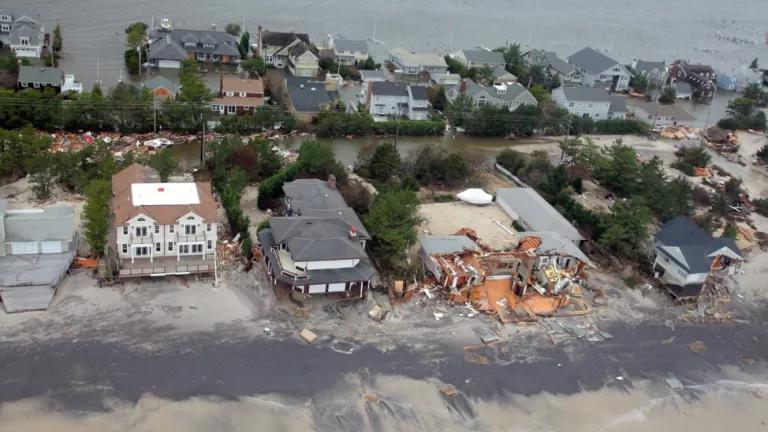FEMA Proposes to Buy Flooded Homes and Let Owners Rebuild

FEMA has proposed allowing owners of homes that have been repeatedly damaged by coastal storms and floods, and that were bought out by taxpayers, to rebuild on the same highly flood-prone land. FEMA’s proposal not only could undermine long-standing property acquisition policy and practice, but also, if implemented, would be a giveaway to developers and coastal property owners at the expense of the American taxpayer. NRDC submitted comments strongly opposing this bad idea and urged FEMA not to move forward with implementation.
The Proposal Undermines FEMA’s Long-Standing Property Acquisition and Open Space Preservation Principles
Currently, FEMA’s buyout policy mandates that when FEMA buys a home that has flooded again and again, the structure be torn down and the land converted into open space. Buyouts that convert the acquired land to open space are a permanent way to mitigate flood risk and help property owners, who desire to do so, move out of harm’s way. Such buyout practices also ensure that the National Flood Insurance Program (NFIP) will not continue to pay to repair and rebuild a house located on land that floods repeatedly.
FEMA has underscored the importance of this buyout practice in numerous documented in numerous regulations and guidance documents:
- “Property acquisition is the most permanent form of flood hazard mitigation.”
- “While many efforts combat flooding, property acquisitions or buyouts rank as the best way to prevent flood damage.”
- “Recognizing that the risk of disaster is increasing as a result of multiple factors, including the growth of population in and near high-risk areas, aging infrastructure, and climate change, FEMA promotes climate change adaptation by … encouraging floodplain and wetland conservation associated with the acquisition of properties in green open space and riparian areas.”
However, FEMA’s proposal flies in the face of these policies and practices and would essentially pay for owners of repeatedly flooded properties to rebuild on the same vulnerable property. This is problematic as repeatedly flooded homes are a big drain on the NFIP.
Between 1978 and 2015, the NFIP paid $5.5 billion to repair and rebuild just over 30,000 severe repetitive loss properties. These homes and businesses have been rebuilt an average of five times, and represent just 0.6 percent of the 5.1 million properties insured through the NFIP, but account for a disproportionate 9.6 percent all damages paid, over that same time period. Given the catastrophic losses the NFIP has incurred since 2015, these numbers have undoubtedly increased. Judging from their history, severe repetitive loss properties can be expected to flood again. Therefore, acquiring these properties and deed restricting the land for open space uses to eliminate future NFIP payouts normally would be a legitimate mitigation option. FEMA’s proposal is not that solution.
FEMA’s High-Cost, Low-Benefit Proposal Is Harmful
Also, it is unclear what problem FEMA is attempting to solve with this proposal.. FEMA can already help pay to elevate the property if the owner wants to stay. FEMA can already pay for floodproofing. FEMA can already help pay for structural retrofits. All of these existing options permit the property owner to remain on the property.
What’s different about FEMA’s new proposal is that it would put substantially more money in a property owner’s pocket before they rebuild. If a property owner has flood insurance, the most they can get is $250,000, the maximum amount of coverage, plus any additional grant assistance for the activities described above. Under the proposal, the homeowner could receive the full pre-flood value of the structure.
By purchasing a damaged house, paying for its demolition, and then allowing the owner to rebuild, FEMA is encouraging a maladaptive practice that does little to reduce long-term flood risk and flood damages. Compared to the cost and benefits of property acquisition with open space requirements, the costs of FEMA’s proposal are likely to be far higher over the long term. Not only are severe repetitive loss properties already known to flood, but many of these properties and those that will become severe repetitive loss properties, are in areas that will be even more likely to flood in the future (due to rising sea levels and increased potential for severe weather events), which means any new structure built on that land will likely be at equal or greater risk of flooding several years from now.
FEMA’s proposal basically would obtain the same result as existing programs, but at a much higher cost to the taxpayer.
FEMA’s Proposal Could Perpetuate Unsustainable Coastal Development
Further, the proposal, if implemented, would likely be a windfall for developers and coastal property owners. FEMA’s proposal creates a perverse incentive for a property owner to accept the pre-market value for the structure and then resell the land to a developer. As experience has shown, there is already a likelihood that a larger, and therefore more expensive, structure will be built on a property following a flood, as this has been found to be the case in the aftermath of Superstorm Sandy in New Jersey. Such a result could actually increase the exposure of the NFIP as any associated damage claims would likely be higher. The proposal could unintentionally benefit wealthier individuals at the expense of lower-income severe repetitive loss property owners that are covered by the NFIP.
Unfortunately, as sea levels rise and extreme storms become more common, many regions of the nation will see their risk of flooding increase. For some flood-prone areas, continuing to repair and rebuild after every flood will become prohibitively expensive. In this context, buyouts that preserve open space are a valuable mechanism for addressing that risk. However, FEMA’s proposal would only serve to perpetuate the problem at taxpayer expense.
